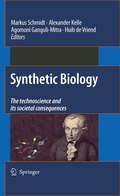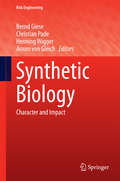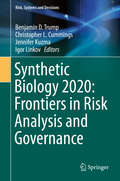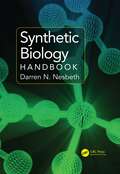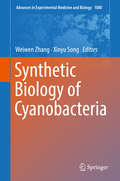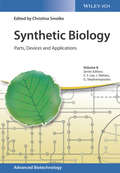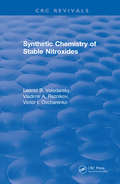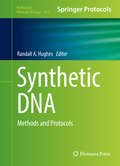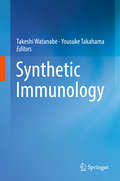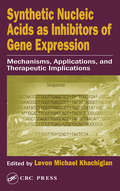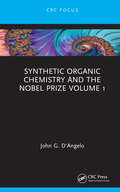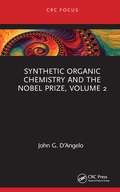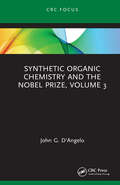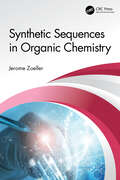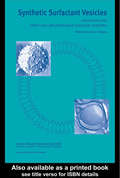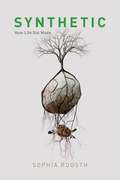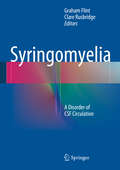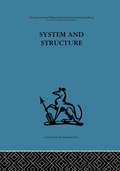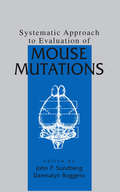- Table View
- List View
Synthetic Biology
by Alexander Kelle Markus Schmidt Agomoni Ganguli-Mitra Huib De VriendSynthetic biology is becoming one of the most dynamic new fields of biology, with the potential to revolutionize the way we do biotechnology today. By applying the toolbox of engineering disciplines to biology, a whole set of potential applications become possible ranging very widely across scientific and engineering disciplines. Some of the potential benefits of synthetic biology, such as the development of low-cost drugs or the production of chemicals and energy by engineered bacteria are enormous. There are, however, also potential and perceived risks due to deliberate or accidental damage. Also, ethical issues of synthetic biology just start being explored, with hardly any ethicists specifically focusing on the area of synthetic biology. This book will be the first of its kind focusing particularly on the safety, security and ethical concerns and other relevant societal aspects of this new emerging field. The foreseen impact of this book will be to stimulate a debate on these societal issues at an early stage. Past experiences, especially in the field of GM-crops and stem cells, have shown the importance of an early societal debate. The community and informed stakeholders recognize this need, but up to now discussions are fragmentary. This book will be the first comprehensive overview on relevant societal issues of synthetic biology, setting the scene for further important discussions within the scientific community and with civil society.
Synthetic Biology
by Bernd Giese Christian Pade Henning Wigger Arnim Von GleichSynthetic Biology is already an object of intensive debate. However, to a great extent the discussion to date has been concerned with fundamental ethical, religious and philosophical questions. By contrast, based on an investigation of the field's scientific and technological character, this book focuses on new functionalities provided by synthetic biology and explores the associated opportunities and risks. Following an introduction to the subject and a discussion of the most central paradigms and methodologies, the book provides an overview of the structure of this field of science and technology. It informs the reader about the current stage of development, as well as topical problems and potential opportunities in important fields of application. But not only the science itself is in focus. In order to investigate its broader impact, ecological as well as ethical implications will be considered, paving the way for a discussion of responsibilities in the context of a field at a transitional crossroads between basic and applied science. In closing, the requirements for a suitable regulatory framework are discussed. The book is intended as a source of information and orientation for researchers, students and practitioners in the natural sciences and technology assessment; for members of scientific and technological, governmental and funding institutions; and for members of the general public interested in essential information on the current status, prospects and implications of synthetic biology.
Synthetic Biology 2020: Frontiers in Risk Analysis and Governance (Risk, Systems and Decisions)
by Igor Linkov Benjamin D. Trump Christopher L. Cummings Jennifer KuzmaSynthetic biology offers powerful remedies for some of the world’s most intractable problems, but these solutions are clouded by uncertainty and risk that few strategies are available to address. The incentives for continued development of this emerging technology are prodigious and obvious, and the public deserves assurances that all potential downsides are duly considered and minimized accordingly. Incorporating social science analysis within the innovation process may impose constraints, but its simultaneous support in making the end products more acceptable to society at large should be considered a worthy trade-off.Contributing authors in this volume represent diverse perspectives related to synthetic biology’s social sciences, and reflect on different areas of risk analysis and governance that have developed for the field. Such perspectives include leading scholarly discussion pertaining to risk assessment, governance, ethics, and communication. The chapters of this volume note that while the first twenty years of synthetic biology development have focused strongly on technological innovation and product development, the next twenty should emphasize the synergy between developers, policymakers, and publics to generate the most beneficial, well governed, and transparent technologies and products possible. Many chapters in this volume provide new data and approaches that demonstrate the feasibility for multi-stakeholder efforts involving policymakers, regulators, industrial developers, workers, experts, and societal representatives to share responsibilities in the production of effective and acceptable governance in the face of uncertain risk probabilities. A full consideration of such perspectives may prevent a world of draconian regulations based on an insufficient or incomplete understanding of the science that underpins synthetic biology, as well as any hesitancy or fear by the public to adopt its eventual products.
Synthetic Biology Handbook
by Darren N. NesbethThe Synthetic Biology Handbook explains the major goals of the field of synthetic biology and presents the technical details of the latest advances made in achieving those goals. Offering a comprehensive overview of the current areas of focus in synthetic biology, this handbook:Explores the standardisation of classic molecular bioscience approaches
Synthetic Biology of Cyanobacteria (Advances in Experimental Medicine and Biology #1080)
by Weiwen Zhang Xinyu SongThis volume highlights recent breakthroughs in the interdisciplinary areas of synthetic biology, metabolic engineering and bioprocess engineering for the production of green chemicals. It also presents practical experimental and computational tools for the design, construction and manipulation of cyanobacteria cell factories. The respective contributions cover new technologies in the field, such as novel genetic transformation techniques and bioinformatics analysis methods and address various aspects of cyanobacterial synthetic biology, offering a valuable resource for students and researchers in the fields of industry microbiology and biomedical engineering.
Synthetic Biology: Parts, Devices and Applications (Advanced Biotechnology)
by Jens Nielsen Gregory Stephanopoulos Sang Yup Lee Christina Smolkeneed new text The inaugural volume of this new reference work in biotechnology is the most comprehensive of its kind on the market, covering everything from DNA synthesis to RNA interference and biosensors. Edited by the renowned scientists Sven Panke of the Swiss Federal Institute of Technology and Christina Smolke from Stanford University.
Synthetic Cathinones
by Jolanta B. ZawilskaOver the last decade, and particularly during the recent five years, a rapidly increasing number of novel psychoactive substance (NPSs), often marketed as “designer drugs”, “legal highs”, “herbal highs”, “research or intermediate chemicals” and “laboratory reagents”, has appeared on the drug market in an effort to bypass controlled substance legislation. NPSs encompass a wide range of different compounds and drug classes but had been dominated by synthetic cannabinomimetics and psychostimulatory synthetic cathinones, so-called β-keto amphetamines. Compounds from the later class were first detected in Europe in 2004, and since then 103 new cathinones have been identified and reported to the European Monitoring Centre for Drugs and Drug Addiction, with 57 during the last two years. Synthetic cathinones – novel addictive and stimulatory psychoactive substances is the first publication of this kind that provides readers with background on chemical structures, detection, prevalence and motivation of use of the very popular group of NPSs. This book also presents comprehensive overview of the mechanisms of action, pharmacological activity, and main metabolic pathways of synthetic cathinones, followed by a detailed discussion of the acute and chronic toxicity associated with the use of these substances. Written by international experts in the field, this multi-authored book is a valuable reference not only for scientists, clinicians and academics, but also for readers representing different professional background who are involved in educational-prophylactic activities directed to harm reduction of psychoactive compounds.
Synthetic Chemistry of Stable Nitroxides (CRC Press Revivals)
by L. B. Volodarsky V.A. Reznikov V.I. OvcharenkoThis important book is devoted to covering the synthetic aspects of nitroxide chemistry. The problems of application and physicochemical properties of nitroxides are considered in the context of the choice of necessary radical structures, convenient precursors, and strategy of the synthesis. The book offers comparisons of the concrete classes of nitroxides to help reveal the structural peculiarities and synthetic abilities of compounds of different classes. It also summarizes data on the magneto-structural correlation for the metal complexes with 3-imidazoline nitroxides and considers the ways in which the molecular design of 2- and 3-dimensional heterospin compounds is capable of magnetic phase transfer in a ferromagnetic state. The book will be a significant reference for chemists, biochemists, spectroscopists, and other users of nitroxides, spin labels, probes, and paramagnetic ligands.
Synthetic DNA
by Randall A. HughesThis volume presents state-of-the art methods for the synthesis, design, assembly, post synthesis processing, and application of synthetic DNA to modern biotechnology. Chapters are divided into three general sections focusing on protocols for the computational design of synthetic DNA sequences, the synthesis, assembly and cloning of synthetic DNA, and post-synthesis error reduction strategies. Written in the highly successful Methods in Molecular Biology series format, chapters include introductions to their respective topics, lists of the necessary materials and reagents, step-by-step, readily reproducible laboratory protocols, and tips on troubleshooting and avoiding known pitfalls. Authoritative and cutting-edge, Synthetic DNA: Methods and Protocols aims to help researchers further their research on manipulate DNA sequences.
Synthetic Gene Circuits: Methods and Protocols (Methods in Molecular Biology #2229)
by Filippo MenolascinaThis volume provides clear and direct protocols to implement automated Design-Build-Test-Learn (DBTL) into synthetic biology research. Chapters detail techniques to model and simulate biological systems, redesign biological systems, setting up of an automated biolaboratory, step-by-step guide on how to perform computer aided design, RNA sequencing, microfluidics -using bacterial cell free extracts, live mammalian cells, computational and experimental procedures, metabolic burden, computational techniques to predict such burden from models, and how DNA parts can be engineered in mammalian cells to sense, and respond to, and intracellular signals in general. Written in the highly successful Methods in Molecular Biology series format, chapters include introductions to their respective topics, lists of the necessary materials and reagents, step-by-step, readily reproducible laboratory protocols, and tips on troubleshooting and avoiding known pitfalls. Authoritative and cutting-edge, Synthetic Gene Circuits: Methods and Protocols aims to ensure successful results in the further study of this vital field.
Synthetic Immunology
by Yousuke Takahama Takeshi WatanabeThis book reviews the emerging studies of synthetic immunology, including the development and regeneration of immune cells, immune organ development and artificial regeneration, and the synthetic approach towards understanding human immune system. Immunology has developed rapidly over the last 50 years through the incorporation of new methods and concepts in cell and molecular biology, genetics, genomics and proteomics. This progress is the result of works by many excellent researchers all over the world. Currently, immunological research has accumulated detailed knowledge on basic mechanisms of immunity and is in the process to change medical practices. Yet, due to the enormous complexity of the immune system, many aspects on the regulation and function of this system remain unknown. Synthetic biology uses gain-of-function rather than loss-of-function approaches. The goals of synthetic biology can be described in a simple phrase "rebuild, alter, and understand," namely, to rebuild minimal functional systems using well-defined parts from nature and then to perturb the system to understand its working principles. Given the richness of accumulated knowledge in molecular and cellular mechanisms of the immune system, we now begin adapting the concepts of synthetic biology to immunology. An immune response is a spatiotemporal phenomenon occurring at a given time and at a specialized place in the body. One goal of synthetic immunology is to reconstruct artificial microenvironments for better understanding of an immune response. We hope this yet-to-be-experimental approach of synthetic immunology and the compilation of this book will aid our further understanding of the immune system and future devising the tools to manipulate the immune system for therapy and prevention of the diseases.
Synthetic Messenger RNA and Cell Metabolism Modulation
by Peter M. RabinovichSynthetic mRNA is an attractive tool for mammalian cell reprogramming that can be used in basic research, as well as in clinical applications. Present mRNA in vitro synthesis is a rather simple procedure, which delivers a high yield of quality product. Various modifications may be introduced into the mRNA by changing the sequence of the DNA template, by modifying the reaction of transcription, or by post-transcriptional modification. mRNA, as a transfection agent, has several advantages over DNA, as mRNA expression is not dependent on nuclear entry and occurs directly in the cytosol. Synthetic Messenger RNA and Cell Metabolism Modulation: Methods and Protocols covers the typical main methods, such as mRNA synthesis, modifications, and delivery. Examples of cell reprogramming and analysis in the fields of immunotherapy and stem cell research are also included. Written in the successful Methods in Molecular BiologyTM series format, chapters include introductions to their respective topics, lists of the necessary materials and reagents, step-by-step, readily reproducible protocols, and notes on troubleshooting and avoiding known pitfalls. Authoritative and easily accessible, Synthetic Messenger RNA and Cell Metabolism Modulation: Methods and Protocols will be of interest to researchers, clinicians, and biotech companies interested in mRNA-mediated cell reprogramming.
Synthetic Nucleic Acids as Inhibitors of Gene Expression: Mechanisms, Applications, and Therapeutic Implications
by Levon Michael KhachigianIn the post-genomic era we have, at our fingertips, an incredible array of genomic sequences from a multitude of complex organisms. There remains, however, the critical need to understand the precise roles individual genes play in complex biological milieu. Bringing together authoritative reviews by renowned international leaders, this book presents cutting-edge research on inhibitors of gene expression and nucleic acid-based drugs. With numerous charts, diagrams, and graphs, the book covers the subject from lab bench to cancer-related clinical trials, making it an up-to-date and critical resource. Coverage includes discussions of ribozyme subtypes, structure-function aspects, and therapeutic applications; DNAzymes, their various subtypes, kinetics and biochemistry, and applications in target validation. Lastly, the mechanisms and multiple therapeutic applications of double-stranded oligonucleotide decoys are described.
Synthetic Organic Chemistry and the Nobel Prize Volume 1 (Synthetic Organic Chemistry and the Nobel Prize)
by John G. D'AngeloThe Nobel Prize is science’s highest award, as is the case with non-science fields too, and it is therefore arguably the most internationally recognized award in the world. This unique set of volumes focuses on summarizing the Nobel Prize within organic chemistry, as well as the specializations within this specialty. Any reader researching the history of the field of organic chemistry will be interested in this work. Furthermore, it serves as an outstanding resource for providing a better understanding of the circumstances that led to these amazing discoveries and what has happened as a result, in the years since. An outstanding resource which enables readers to better understand the conditions that led to these Nobel Prize amazing discoveries To an extent the roots of organic chemistry have been forgotten or lost and this set of volumes bridges the gap Unique set of volumes, no other book publication in the field competes and only press releases announcing the prizes from recent years exist "More than any other branch of chemistry, organic chemists look to history, so the readers will certainly enjoy this compilation " Appeals to a diverse audience including upcoming as well as modern practicing chemists, and provides the historical context of these discoveries
Synthetic Organic Chemistry and the Nobel Prize, Volume 2 (Synthetic Organic Chemistry and the Nobel Prize)
by John G. D'AngeloThe Nobel Prize is the highest award in science, as is the case with nonscience fields too, and it is, therefore, arguably the most internationally recognized award in the world. This unique set of volumes focuses on summarizing the Nobel Prize within organic chemistry, as well as the specializations within this specialty. Any reader researching the history of the field of organic chemistry will be interested in this work. Furthermore, it serves as an outstanding resource for providing a better understanding of the circumstances that led to these amazing discoveries and what has happened as a result, in the years since.
Synthetic Organic Chemistry and the Nobel Prize, Volume 3 (Synthetic Organic Chemistry and the Nobel Prize)
by John G. D'AngeloThe Nobel Prize is the highest award in science, as is the case with nonscience fields too, and it is, therefore, arguably the most internationally recognized award in the world. This unique set of volumes focuses on summarizing the Nobel Prize within organic chemistry, as well as the specializations within this specialty. Any reader researching the history of the field of organic chemistry will be interested in this work. Furthermore, it serves as an outstanding resource for providing a better understanding of the circumstances that led to these amazing discoveries and what has happened as a result, in the years since.
Synthetic Peptide Vaccine Models: Design, Synthesis, Purification and Characterization
by Mesut KarahanA new generation of technological vaccines protect against many infectious diseases. This book describes synthetic peptide-based vaccine prototypes – the future of vaccination. Production of peptides becomes simple using automatic synthesizers. Peptides are weak immunogen and need adjuvants to provide an effective autoimmune response, which is why peptide antigens are conjugated with biopolymers and loaded with nanoparticles. The book illustrates the use of peptides vaccine systems and makes predictions of future development not only for infectious diseases, but also for cancers and brain diseases such as Alzheimer, Parkinson and psychiatric diseases. Key Features Summarizes current studies on technological vaccines Describes the uses of vaccines for the prevention of brain diseases Reviews the ways different polymers are used to enhance vaccine efficacy
Synthetic Sequences in Organic Chemistry
by Jerome ZoellerDrawing on the vast amount of experience the author has gained from working in industrial and university laboratories, this collection of excerpt reports contains essential details from literature relevant to the synthesis of compounds on a milligram to kilogram scale. The excerpts are composed using ChemDraw software and compiled in a Word document. A number of the compounds that have eluded efficient preparation in the past are now presented. Material which will improve any chemist's existing synthetic methodology can be found here. Each of the six chapters, with eighty excerpts, illustrates a novel application of syntheses selected from twenty-first-century literature. Features: This professional text describes many of the classical and contemporary methods of synthesis that have recently found great value in the preparation of needed target compounds in the required quantities. Each example is extracted from a specific literature publication, which the user then would examine for details. This user-friendly professional text provides enormous aid in designing synthetic sequences. Appeals to a broad audience in both academic and industrial laboratories, basically any chemist in need of designing a synthetic sequence or just selecting a single reaction. Author has a vast amount of experience gained from working in academic and industrial laboratories.
Synthetic Surfactant Vesicles: Niosomes and Other Non-Phospholipid Vesicular Systems
by L F UchegbuThe self-assembly of synthetic surfactants and other non-phospholipids into vesicles was first studied in the 1970s by cosmetic scientists when non-ionic surfactant vesicles or niosomes were reported. Since this time a large body of research has sought to define these systems primarily as drug carriers and also as features of interest to the colloid scientist. Synthetic surfactant vesicles, as the name implies, may also be fabricated from a vast array of amphiphiles, including a number of pharmaceutically acceptable materials. They may also be prepared in a variety of shapes and sizes and have a number of applications. This book is designed to serve as an introductory text to the science of non-phospholipid vesicles and will be of use to colloid, drug delivery, cosmetic, and materials scientists. It aims to acquaint the reader with the physicochemistry and biomedical applications of these synthetic surfactant non-phospholipid vesicles. Part one introduces the reader to physicochemical aspects of these synthetic surfactant dispersions and explores the diversity of materials that may be used to formulate vesicles. Part two details methods of vesicle preparation and the application of synthetic surfactant vesicles in a variety of fields ranging from anti-cancer chemotherapy to immunization.
Synthetic: How Life Got Made
by Sophia RoosthIn the final years of the twentieth century, émigrés from engineering and computer science devoted themselves to biology and resolved that if the aim of biology is to understand life, then making life would yield better theories than experimentation. Armed with the latest biotechnology techniques, these scientists treated biological media as elements for design and manufacture: viruses named for computers, bacterial genomes encoding passages from James Joyce, chimeric yeast buckling under the metabolic strain of genes harvested from wormwood, petunias, and microbes from Icelandic thermal pools. In Synthetic: How Life Got Made, cultural anthropologist Sophia Roosth reveals how synthetic biologists make new living things in order to understand better how life works. The first book-length ethnographic study of this discipline, Synthetic documents the social, cultural, rhetorical, economic, and imaginative transformations biology has undergone in the post-genomic age. Roosth traces this new science from its origins at MIT to start-ups, laboratories, conferences, and hackers’ garages across the United States—even to contemporary efforts to resurrect extinct species. Her careful research reveals that rather than opening up a limitless new field, these biologists’ own experimental tactics circularly determine the biological features, theories, and limits they fasten upon. Exploring the life sciences emblematic of our time, Synthetic tells the origin story of the astonishing claim that biological making fosters biological knowing.
Syphilis: A Short Biography
by Andrew P. ZbarSyphilis is an illness with mythology. The story of its origin, dissemination and treatment have all been mired in confusion, a mix of reality and quackery. I have tried to put the organism as the principal protagonist of the story, firmly in an historical focus which centres more on its social impact than on its particular medical management. A diagnosis of Syphilis had personal and community consequence and its impact transcended into the arts. Despite the discovery of an effective treatment to which the organism has fortunately failed to mutate, the restrictions in available management have been social and a result of prejudice towards its victims. This may explain why it is once again on the global rise in places where access to the most basic antibiotics remains limited. This book uniquely considers the sociological sequel of infection, the wider influence extending beyond the physical that has become its legacy.
Syringomyelia
by Graham Flint Clare RusbridgeSyringomelia is a relatively rare clinical entity in which fluid-filled cavities develop within the spinal cord. Although modern imaging technologies usually permit an accurate diagnosis at an early stage, syringomyelia remains an enigmatic condition. This reference monograph provides an up-to-date account of the present state of understanding of syringomyelia and related disorders. The editors aim to document the best clinical practice in diagnosis and treatment and to provide clear guidance on how to reduce the incidence of severe outcomes. New challenges are addressed, including the appropriate management of the increasing number of apparently idiopathic syrinx cavities that are detected. In addition, controversies in current practice and directions for future research are fully discussed. Syringomelia will be an invaluable source of information for experts in the field, specialists in various related disciplines and other interested health care professionals.
System Reengineering in Healthcare: Application for Hospital Emergency Departments (Studies in Systems, Decision and Control #172)
by Salman Ben Zayed Abdullah Bin Gani Mohd Khalit Bin OthmanThis book presents an advanced systematic mapping review (SMR) and state-of-the-art taxonomy of emergency departments (EDs). Focusing on the patients’ level of fulfilment and how it can be enhanced, it examines existing problems like waiting periods and overcrowding and how these can be alleviated to provide a better service. The author examined research papers from 1964 to 2018, and developed six research questions, organising them using mapping studies, the primary objectives of which were firstly, to obtain a common understanding of the problems that need to be highlighted in EDs, and secondly, to re-analyse the methods used. Focusing on quality, the book encourages citations of experimental methods from important studies concerning EDs that can improve services. Through different research papers, various thematic areas in the healthcare sector were examined, like the determination of the relative efficiency of pre-discharge interventions; the analysis of care and managing common indications during the last stages of life; using e-Health to enhance effectiveness and proficiency; the seriousness of patient differences among EDs; the identification of quality problems in healthcare contexts; existing opportunities and the suggested plans. The book concludes that an analytical decision-making process should be used to assess a health technology on the basis of its performance. It stresses the importance of updating this analytical system frequently.
System and Structure: Essays in communication and exchange second edition
by Anthony WildenTavistock Press was established as a co-operative venture between the Tavistock Institute and Routledge & Kegan Paul (RKP) in the 1950s to produce a series of major contributions across the social sciences. This volume is part of a 2001 reissue of a selection of those important works which have since gone out of print, or are difficult to locate. Published by Routledge, 112 volumes in total are being brought together under the name The International Behavioural and Social Sciences Library: Classics from the Tavistock Press. Reproduced here in facsimile, this volume was originally published in 1980 and is available individually. The collection is also available in a number of themed mini-sets of between 5 and 13 volumes, or as a complete collection.
Systematic Approach to Evaluation of Mouse Mutations
by John P. Sundberg Dawnalyn BoggessExperts from The Jackson Laboratory and around the world provide practical advice on everything from how to establish a colony to where to go for specific mutations. The book includes information on medical photography, grafting procedures, and how to map the genes and evaluate the special biological characteristics of mice. It also discusses how to maintain a colony of mice that breed with difficulty, how to approach mapping spontaneous mutations, how to set up systems to evaluate a specific antibody, how to perform simple measurements that yield a large amount of information, and how to access mouse informatics on the Web.
